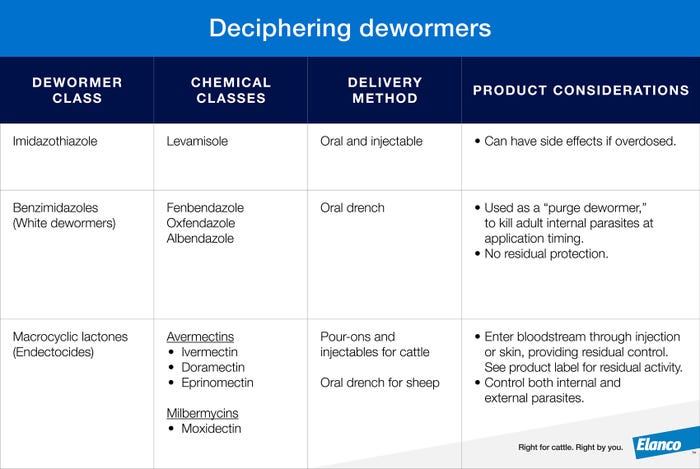Choosing the best cattle dewormer for your beef herd
Uncover the key factors that can help you overcome internal parasites and effectively maximize the health and profitability of your herd.
March 1, 2024

At the heart of every successful cattle operation lies a hidden challenge: internal parasites. These unseen troublemakers can silently sabotage your herd’s health. The use of dewormers can help you overcome these pesky parasites to effectively help maximize the health and profitability of your herd.
Even when symptoms of parasites aren’t visible, subclinical infections can lead to significant losses. Researchers have estimated that without the intervention of dewormers, cow-calf producers could experience an estimated increase to break-even cost of $165 per head.1 Zoom out to the entire beef production system and the impact is much greater, costing up to $1901 per head in break-even prices.
Deciphering dewormer methods
Dewormers come in several different forms, which allows selection to be tailored to the animal, parasite of concern, season, management style, economics, timing and ease of use. Pour-ons, injectables and oral drenches are the three delivery methods used for parasite control in cattle. While each has its pros and cons, they all have their place in the industry.
In addition to delivery method, there are currently three dewormer classes available: benzimidazoles, imidazothiazoles and macrocyclic lactones. When it comes to choosing a dewormer, many products are in the same chemical class, even if the brand name is different. This can make it confusing when trying to choose the right dewormer for your operation’s needs.

Photo submitted by Elanco Animal Health
Moxidectin is the only active ingredient in the milbemycin chemical class and is dung beetle and earthworm-friendly.2,3 Earthworms and dung beetles play a vital role in pasture management, recycling cattle dung, improving soil health and keeping other cattle parasites in check.
No matter the type of dewormer you choose, there are growing concerns surrounding potential parasite resistance to available products. The first step when choosing your deworming product is understanding what parasites are present. By knowing the parasites present, one can make better choices of which product(s) may be best suited for one’s operation. Several tools exist to evaluate parasites, the species present and the effectiveness of a given treatment. Your Elanco technical consultant can guide you in how to perform a species-specific quantitative analysis (SSQA) to evaluate the parasite species present, the need for treatment and potential treatment options.
Right product at the right time in the right animal
As imperative as it is to use the right product for the right parasite, it is equally important to use the product at the right time for the best results. Working with your herd veterinarian can help identify the strategic times to deworm to make the most out of management practices.
Deworming should not be a “just because we always have” process. It should be a well-thought-out management strategy based on specific factors including type of operation, type of pasture, local climate and timing of other management practices. To ensure effective deworming, always follow the product label and dosing instructions, accurately weigh each animal to prevent underdosing and only deworm when necessary. You may also use two products from differing classes concurrently but only if evidence of reduced efficacy exists.
By following a well-considered deworming strategy as part of a parasite management program you can mitigate the negative impacts of parasites and enhance your cattle's well-being, which influence one’s bottom line. Remember, a strategic approach to deworming not only benefits your cattle but also contributes to the long-term sustainability and profitability of your cattle operation.
To learn more about strategic parasite control, talk with your veterinarian or Elanco technical consultant.
Keep Cydectin out of reach of children.
Cydectin, Elanco and the diagonal bar logo are trademarks of Elanco or its affiliates. ©2024 Elanco or its affiliates. PM-US-24-0114
References:
1 Lawrence J, Ibarburu M. Economic analysis of pharmaceutical technologies in modern beef production. Proceedings of the NCCC-134 Conference on Applied Commodity Price Analysis, Forecasting, and Market Risk Management. 2007:10-11.
2 Suarez CV, Lifschitz, A, Sallovitz, J, et al. Effects of fecal residues of moxidectin and doramectin on the activity of arthropods in cattle dung. ScienceDiet. 2009:72:1551-1558.
3 Environmental Assessment. Cydectin® moxidectin 0.5% Pour-On for Cattle. Fort Dodge Animal Health, June 1997.
You May Also Like
.png?width=300&auto=webp&quality=80&disable=upscale)


.png?width=300&auto=webp&quality=80&disable=upscale)
